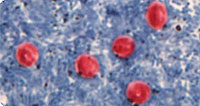By Linda Weiford, WSU News
 PULLMAN, Wash. – Twenty-two years ago this month, residents of Milwaukee started falling ill with nausea, diarrhea and abdominal cramps. At first, a highly contagious intestinal virus was blamed. But as symptoms struck tens of thousands of people – closing schools and businesses and nearly bringing the city to a standstill – health officials discovered the culprit: a tiny, pink-colored parasite.
PULLMAN, Wash. – Twenty-two years ago this month, residents of Milwaukee started falling ill with nausea, diarrhea and abdominal cramps. At first, a highly contagious intestinal virus was blamed. But as symptoms struck tens of thousands of people – closing schools and businesses and nearly bringing the city to a standstill – health officials discovered the culprit: a tiny, pink-colored parasite.
Cryptosporidium, also known as crypto, had made its way through Milwaukee’s water treatment plant and into the city taps. Sickening more than 400,000 people and killing 69, it remains the largest waterborne outbreak in U.S. history. Since then, utilities nationwide have made improvements in water treatment and monitoring.
Hardy foe gains stranglehold

Public water technology to prevent crypto may have improved, but not the drugs to treat it, said Washington State University researcher Jennifer Zambriski of the Paul G. Allen School for Global Animal Health based in the College of Veterinary Medicine. Once the organism infects the small intestines, its onslaught on the body is just as toxic as it was 22 years ago, she said.
“Crypto is hardy and doesn’t die easily. When someone contracts it, there’s simply no drug to make it go away,” said Zambriski, whose research focuses on finding ways to disrupt the parasite’s pathway through the digestive tract – before it gains a stranglehold on its host.
Which is a big deal, because the parasite still lurks – in ponds, streams, day care centers and swimming pools. In developing countries like Kenya and industrial ones like the United States, it continues to make waves.
 Cryptosporidiosis, the disease it causes, is one of the most frequently occurring waterborne diseases among humans in the U.S., according to the U.S. Centers for Disease Control and Prevention. And in Asia and Africa, the parasite is a leading cause of diarrheal disease and death among infants. (See Lancet study, 2013: http://www.sciencedirect.
Cryptosporidiosis, the disease it causes, is one of the most frequently occurring waterborne diseases among humans in the U.S., according to the U.S. Centers for Disease Control and Prevention. And in Asia and Africa, the parasite is a leading cause of diarrheal disease and death among infants. (See Lancet study, 2013: http://www.sciencedirect.
com/science/article/pii/
S0140673613608442).
Toxic rampage
These soft-pink colored pathogenic foes, appearing “almost cute” under a microscope, according to Zambriski, live in the intestines of infected humans and certain animals and are shed in the stool. Once outside the body, a tough outer shell allows them to survive in dirt, water and food for 18 months or longer.
“Bleach, chlorine, freezing backwater streams and water purifying tablets – they can’t kill crypto,” she said.
Whether through contaminated water or an infected person’s unclean hands, the parasites are easily transmitted to humans.
“Ingesting just a small amount can deliver a severe spell of diarrhea to those who are healthy and a grave illness and even death to infants or people with weakened immune systems,” Zambriski said.
Let’s say that 10 or so crypto make their way to the epithelial cells lining the small intestines. There, they actually form structures that safely house them and provide nutrients. This intriguing setup, deep within the tightly-packed epithelial cells, helps the microbes resist antibiotics and other drugs, said Zambriski.
“Within one week, 10 parasites can multiply into millions,” she said.
Tackling crypto, and more, in Kenya
Zambriski’s research also takes her to Kenya, where the parasite takes a toll on infants and toddlers. The goal is to figure out how crypto spreads between people, livestock and water, she said: “For interventions to have the greatest impact, knowing this is crucial.”
Her work in Kenya is part of the Allen School’s broader mission to track the health and livelihood of families and the livestock they own.
“Our studies indicate that healthy livestock are a net benefit to the economic and nutritional security of the families, whereas sick animals may pose a risk for transmission of zoonotic pathogens such as crypto,” said the school’s director, Guy Palmer, a veterinary infectious disease expert.
Contacts:
Jennifer Zambriski, WSU veterinary epidemiologist, 509-335-4514, jzambriski@vetmed.wsu.edu
Linda Weiford, WSU News, 509-335-7209, linda.weiford@wsu.edu